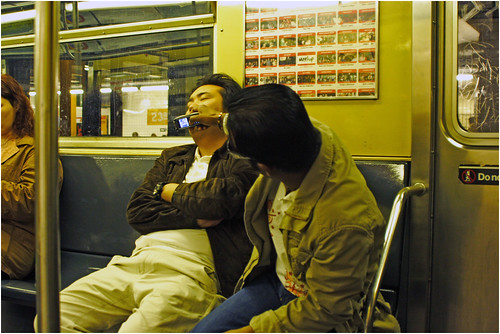 In the world of train car construction, there aren’t too many choices. Alstom and Kawasaki dominate the field, and both enjoy hundred-million-dollar contracts from the MTA. But Altsom, who made headlines a few years back for tardy delivers after their cars suffered major damages, is at it again.
In the world of train car construction, there aren’t too many choices. Alstom and Kawasaki dominate the field, and both enjoy hundred-million-dollar contracts from the MTA. But Altsom, who made headlines a few years back for tardy delivers after their cars suffered major damages, is at it again.
This time, Alstom has fallen another five months behind schedule in delivering R160s to New York, and the MTA doesn’t seem keen on penalizing the company. Bruce Golding of The Post has more:
The problem-plagued French company building New York’s new high-tech subway cars has fallen five months behind schedule without being penalized by the MTA, The Post has learned. Alstom Transport even won a contract extension in July for $700 million more of the cars, despite its dismal deliveries.
Alstom’s upstate Hornell factory has only turned out about 80 of the R160-model cars since starting production last year, an industry source told The Post. The company was supposed to have delivered about 200 of the total 400 cars under its original contract.
According to Golding’s article, the contract Alstom signed with the MTA contains a late-delivery provision. Allegedly, Alstom must pay $800 a day for late deliveries on four-car trains and $1000 a day for five-car trains. So far, no fines have been levied against the Paris-based company.
Now, doesn’t that strike you as silly? The MTA is foisting a fare hike on the public because they won’t have enough money soon. Well, if these charges against Alstom are true, the MTA not has kept rewarding a perennially delayed company but also has some free money awaiting them. Just enforce the terms of the contract, and voilà, cash.

 As the details and inevitability of the
As the details and inevitability of the  New York City: Counterintuitively these days, one of the greatest aspects of the MTA and New York City subways are the fares. For a base fare of $2, a rider can go from Far Rockaway to Pelham Bay Park. As the crow flies, that’s around 20 miles. Via the subway, it’s a long trip through Queens, Brooklyn and the Bronx. Meanwhile, as the
New York City: Counterintuitively these days, one of the greatest aspects of the MTA and New York City subways are the fares. For a base fare of $2, a rider can go from Far Rockaway to Pelham Bay Park. As the crow flies, that’s around 20 miles. Via the subway, it’s a long trip through Queens, Brooklyn and the Bronx. Meanwhile, as the  Washington D.C.: With a tiered fare system, the further one travels in the WMATA, the more one pays. The 7.68-mile trip from Silver Spring, Maryland, to Dupont Circle costs $1.85 at off-peak hours and $2.35 most of the day. A trip to the airport can cost over $3. Considering that the New York subways run 24 hours a day and the WMATA’s do not, we’re getting the better deal here.
Washington D.C.: With a tiered fare system, the further one travels in the WMATA, the more one pays. The 7.68-mile trip from Silver Spring, Maryland, to Dupont Circle costs $1.85 at off-peak hours and $2.35 most of the day. A trip to the airport can cost over $3. Considering that the New York subways run 24 hours a day and the WMATA’s do not, we’re getting the better deal here. Boston: Late in 2006, the Massachusetts Bay Transportation Authority unveiled the CharlieCard, a discounted fare card similar to our Metrocard. With the advent of the CharlieCard, MBTA instituted a discounted fare of $1.85 for card users and a $2 fare for all others. Again, this system is charging more per fare than the MTA with all of those discounts and Unlimited Ride Metrocards, and again, the MBTA operates a system that doesn’t run 24 hours. New York wins.
Boston: Late in 2006, the Massachusetts Bay Transportation Authority unveiled the CharlieCard, a discounted fare card similar to our Metrocard. With the advent of the CharlieCard, MBTA instituted a discounted fare of $1.85 for card users and a $2 fare for all others. Again, this system is charging more per fare than the MTA with all of those discounts and Unlimited Ride Metrocards, and again, the MBTA operates a system that doesn’t run 24 hours. New York wins. So you know that whole IKEA thing they’re building in Red Hook much to the chagrin of
So you know that whole IKEA thing they’re building in Red Hook much to the chagrin of 












 Update 1:26 p.m.: The MTA has released the complete survey info. You can get it
Update 1:26 p.m.: The MTA has released the complete survey info. You can get it  What’s in The Daily News? I’ll tell you what’s in The Daily News. A story about the
What’s in The Daily News? I’ll tell you what’s in The Daily News. A story about the 
 The 8.5-mile Second Ave. Subway took one giant leap toward reality when the Federal Transit Administration
The 8.5-mile Second Ave. Subway took one giant leap toward reality when the Federal Transit Administration  Of all of the charges levied against Mayor Bloomberg’s
Of all of the charges levied against Mayor Bloomberg’s 
